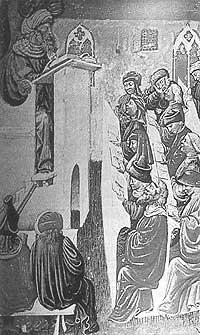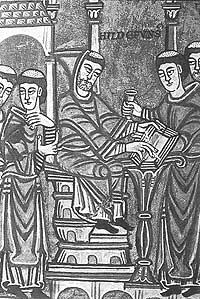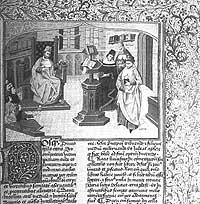History of Science: Universities and Ecochemistry
Universities and universities Universities

We are in the tenth century. In the field of science, Muslim representation cannot be denied. However, in the Christian world we can see the beginning of a revival. At the base of this rebirth were the classical knowledge collected and transmitted in some way by people like Erecen, Beda Agurgarri or her. There were also other more pragmatic reasons. For example, the usual studies received by the seminarians were not enough for the role that priests had to play in that society, or the expansion of trade required a closer people to be able to carry out written relationships and calculations. In short, the Society needed another level of knowledge.
At this time, each cathedral and many monasteries had schools for the students who were produced for the priest. To them began to go all he wanted to learn, the seminarians and then those who were not going to be priests. Then those ecclesiastical schools were too few to respond to the need and new secular schools emerged. These new schools had to create their own cities in places that sometimes depended on the Church and in which the Church did not arrive. Each of these ecclesiastical schools had a responsible professor acting as director. It was called magister scholarum or scholasticus. In that society the teaching was gaining fame and the scholasticus came to have a great influence. For this reason, in order to be a teacher of schools created outside the Church and the Church, it was necessary to obtain the authorization of exhibition (that is, the Council of Priests) and this, at least in the beginning. He gave it himself.
In Salorno there was a secular medical school for a long time. IX. In the eighteenth century the doctors of Salero were very well known. But it must be recognized that the birth of what we now know as a university occurred in Bologna. Towards the year 1000, in the school of Bologna there was a great revival of legislative studies, conquering many foreigners. In it, foreign students and to defend themselves from the abuses of the locals, they constituted a corporation, but with the passage of time, the corporation had the participation of foreigners and locals who were called Universitas. In Bologna the corporation hired its faculty and, therefore, the responsibility and leadership of the university depended on the students. XII. In the eighteenth century, the faculties of philosophy and medicine adhere to law.
At the same time (XII. At the beginning of the twentieth century), but soon after in Bologna, the professors of the School of Dialectics of Paris constituted a community or university. This community developed a regulation of its own functioning. This Regulation was taken as a pattern by most European universities. Therefore, in Oxford or Cam-bridge, power has always been in the hands of students and not teachers (at least a part) as in Bologna or Scotland.

And, in line with the universities of Bologna and Paris, then others will come: 1167 Oxford, 1209 Cambridge. 1222 de Padua, 1224 de Naples, 1227 de Salamanca, 1300 de Lleida, 1347 de Praha, 1364 de Krakow, 1367 de Vienna, 1.410 de Saint Andrews... In Europe he had sown the university phenomenon.
Universitas Universitas
The meaning of the word was nothing more than community. In some places, as in Bologna, at first this community was of students. On other occasions, in Paris, for example, teachers (and elsewhere, such as Gipuzkoa, were used to express some town councils. As witness Lezo, Errexil, etc. There they are). However, in all places, shortly before or after, both teachers and students participated in these communities or universities. In 1208, for example, in the Paris Teachers Corporation the students were admitted and then it was called Universitas magistrorum et scholarium; summing up, Universitas or University.
After the Carolinic era, educational themes were divided into the initial trivium (grammar, rhetoric and dialectics) and the upper quadrivium (music, arithmetic, geometry and astronomy). While the first was in charge of the study of words, the second was in charge of things. The music was expressed as a semi-mystical doctrine of the numbers; the geometry was nothing more than a series of euclidean propositions without demonstration; the arithmetic, which was used for calculations and astronomy, among other things, because it helped to fix the Easter day, were considered very necessary. But all were treated as an introduction to the study of theology. Throughout the Middle Ages, the distribution of the themes observed in the initial growth was maintained. These were called septem liberal arts. Here that liberal means that they had no goal of making money and were for a free man.
As for the development of science, although at first the university aroused hope, later (and because of the scholastic prevailing at that time) it was very fossilized, so the university of the time should be seen as a barrier to science. Therefore, to better understand this situation, we have to look (even if it is only light) at the world of scholastics.
Scholasticate

One of the deepest thinkers given the Middle Ages is the Great Albert of Cologne (1206-1280). Taking and relating Aristotelian, Jewish and Muslim elements, he weaved, like the workers' spider, a powerful web. In it were found all the knowledge about astronomy, geography, botany, zoology and medicine of yesteryear, created by himself.
The work of Alberto relates, on the one hand, to the works of Grosseteste and Bacon that were contemporary and that we have seen in the other article, and, on the other, opened the way to a more systematic philosophy of Thomas Aquinas, his future student. The Aquinas mentality, although less scientific than that of its professor, influenced more in the development of history and the science of philosophy. Thomas followed the rationalization of the knowledge of the time initiated by Alberto and extended the idea of the intelligible Universe.
These two thinkers, Alberto Handia and Thomas Aquinas, made a hard revolution in religious thought. From Plato to Saint Augustine it was recognized that man was a certain union between the thinking soul and the living body. Each of these elements was, in fact, something complete. In each soul they thought that God sowed some ideas before being born. This scheme was very well related to some teachings of the Church, such as the eternal life of the soul or the very idea of the human being with God.
Aristotle showed that the theory of man and the known was radically different. Neither the body, nor the soul, neither one nor the other, are whole in themselves; they are part of another, that is, of the human being. On the other hand, prenatal ideas do not exist. These are constructed from the reasonably obtained data and from the principles that are perceived in themselves, such as that of causality. The idea of God is not born with us, but through a hard rational process. Although from a religious point of view this model presented some difficulties, since it gave a better expression of the world we see, both Albert and Thomas accepted it. The latter took on an enormous task for Christian ideas to fit the model of Aristotle.

However, the philosophy of Aristotle, although more scientific than that of Plato, was opposed to certain scientific achievements. The conclusion was more damaging to Science than harmful, of course, because the philosophy achieved by success and acceptability made scientific thought not to leave the theological-philosophical consideration. One of the worst enemies of the development of the new science was the Aristotelism of St.Thomas, the scholastic.
St.Thomas was born around 1225 in the family of the Count of Aquinas in the South of Italy. At the age of eighteen he entered Dominican. After studying in Cologne under the direction of Albert the Great and teaching in Paris and Rome, he died in the forties in 1274.
In his works St.Thomas recognizes two sources of the known: faith and reason, that is, the mysteries of the Christian faith (as shown by the Bible, the Father of the Church and tradition) and the truths of human reason. But not the truths that each one believes, but thought that the best ways to achieve them were those of Aristotle. These two sources of the known cannot be contrary; both came from a single point, God. Therefore, philosophy and theology were to be reliable and, in this way, thought that God's own existence could be achieved by reason. On the contrary, the mysteries would not be demonstrable by reason, even if they were not contradictory. These would have their place outside philosophy and in dogmatic theology.
For Eskolastika the goal of human reason was to study and listen to God and nature, that is, to try to reasonably express the scheme of all existence. Although the starting point was very discreet, the scholastic put the reason on high. Thomas took as a line the logic and science of Aristotle. This logic was based on syllogisms, that is, they believed that, after accepting some direct premises, the correct use of reason reached the direct consequences and, therefore, these conclusions remained as demonstrated. For this reason, the premises were to be undeniable and for this reason the reason was to be based on ecclesiastical authority or on axioms intuitively accessible at the level of Nature. Therefore, all responsibility was put on an intellectual level, that is, out of research through the experiences of Nature. Along with this, as Aristotle showed, the aquinas and his followers recognized that the human being was a center and objective of the Universe and that the world should be understood through human sensation and psychology.

All this was possible thanks to the physicist of Aristotle, the weakest part of his doctrine: the body was not the association of a lot of atoms, as Democritus showed, but a subject. Each theme has an essence and then some qualities: weight, heat, color, ..., for example. Finally, to a lesser extent, we would have its place and time. While all these last are decisive, the greatest importance lies in the essence (that is, in the substance), even if one and the other are the proper and necessary ingredients of each moment. Therefore, if heaviness is an anti-lightness quality, it is very easy to understand the theory of the natural position of each body of Aristotle: while the heavy bodies tend to descend, the light ones will be ascending and, therefore, those of greater weight fall faster than those of less weight. At this point the scholastics had strong debates with Galileo.
St.Thomas accepted Ptolemy's astronomy as a working hypothesis (where it is demonstratio sed suppositio quaedam), but his followers introduced it into the tomastic system forgetting it. Just as man was the center of all things, the Earth would be the center of the University and revolved around the spheres of air, ether, and fire carrying the sun, stars, and planets.
Eliminating some point, such as the perpetuity of the world (which opposes the creative doctrine), all Aristotelian science was accepted in scholastics. Based on the idea that all movements needed a constant driving force, St.Thomas drew some conclusions according to the theology of his time. Accepting the conclusions as something credited, the premises were more forceful and in this way natural knowledge was integrated into theology, forming a rigid structure. Therefore, any attack on the philosophy or the science of scholastics was considered to be carried out on the Christian faith.
The scholastic has had a great and long influence. Although the scholastics of the following centuries oppose the new science that would be born in the Renaissance, it can be said that the undeniable rationality put by the Scholastics provided the necessary environment to create a new science. Somehow, science was a revolution against the aforementioned rationalism, that is, regardless of the reason and previous schemes made, the resource to the phenomena that appeared in nature. However, the rationalism of the scholastics gave the impression of a global and structured thought. On the other hand, he gave science the belief that the effect is the same when the causes are the same. Without this belief science would make no sense. Therefore, and among other things, science also owes to scholastics.





